How to Write an Eviction Letter to a Tenant
An eviction notice is a letter sent by a landlord to a tenant to inform them that they must fix a certain problem or vacate the property within a certain number of days. Eviction notices are usually sent if the tenant has failed to pay rent, but are also used if the tenant has violated the terms of the lease agreement.
In some cases, the landlord may believe the problem is not fixable and send what's known as an incurable eviction notice. In this case, the tenant has no choice but to vacate the property within a certain number of days.
It's also important to note that each state has its own laws and requirements for eviction notices, so you may need a notice specific to your state, which you can find below.
- When an Eviction Letter is Needed
- How to Handle the Eviction Process
- What Should be Included in the Eviction Notice?
- Free Eviction Notice Sample
- Eviction Notice FAQs
What are other names for an eviction notice?
As a reference, there are three kinds of notices:
1. Pay Rent or Quit Notices ("Failure to Pay Rent")
The tenant has 3 to 5 days (check your local housing laws) to pay rent or leave.
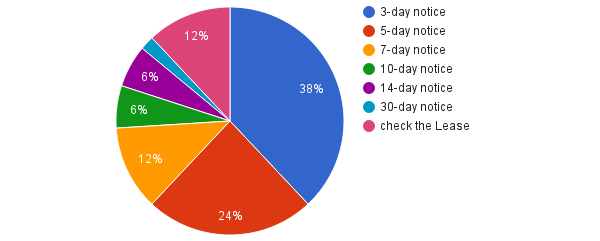
Most state eviction laws agree that tenants should pay their rent on time. More than a third of the states require landlords to give a minimum 3-day eviction notice when rent is late or overdue, while almost a quarter of the states require a minimum of 5-days, and only six states require 7-days.
2. Cure or Quit Notices ("Lease Violation")
The tenant has a certain amount of time to correct or "cure" a problem like violating a no smoking or no pet policy. Otherwise, they must leave or "quit" the premises.
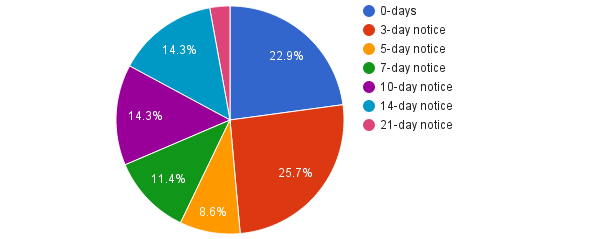
States vary widely on the minimum number of days a landlord should give tenants to cure the default (i.e., no longer violate a provision of the lease).
If a tenant has broken one of their promises in the lease agreement, nine states require that landlords give tenants a minimum 3-day eviction notice. Interestingly, eight states do not require a minimum notice since the lease already spells out the obligations, and the tenant is perhaps assumed to have broken the lease knowingly.
3. Unconditional Quit Notices (End "Month-to-Month")
The tenant cannot pay rent or correct the problem because, on multiple occasions, they have:
- failed to pay rent on time
- violated the lease agreement
- seriously damaged (or is currently damaging) the premises
- committed a crime on the premises (like selling drugs or running a prostitution business)
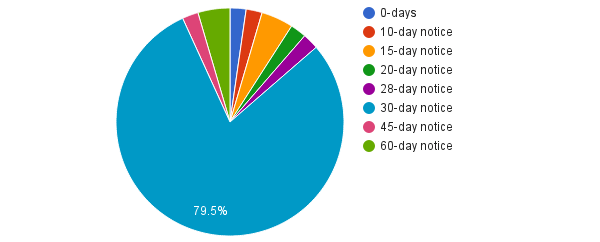
Most states (more than ⅔) require only a 30-day eviction notice to end a month-to-month or holdover tenancy, but some states like Delaware and Georgia provide a more tenant-friendly 60-day notice.
Unconditional quit notices are also used to end an unwanted landlord-tenant relationship with someone who has overstayed their lease (i.e., a Tenant at Sufferance).
What is the difference between a "Tenant at Will" and a "Tenant at Sufferance"?
Most states give more protection to a "Tenant at Will" than a "Tenant at Sufferance."
A tenant at will is usually staying on the premises with the landlord's permission, so states often give such tenants more advanced notice (i.e., 30-day notice). In contrast, a tenant at sufferance (i.e., a holdover tenant) stays on the premises without the landlord's permission and gets less time for when a landlord can begin an eviction (i.e., usually no advanced notice is required).
Here's an easy to understand chart describing the differences:
Tenant at Will vs. Tenant at Sufferance
| Tenant at Will | Tenant at Sufferance |
|---|---|
| Landlord permission given | Landlord does NOT give permission |
| Month-to-month lease (written or verbal) | Landlord ends month-to-month lease |
| Invalid lease (i.e. no rent amount) | Landlord sends a Notice to Quit |
| Written lease ended or expired BUT 1. Landlord accepts your rent 2. No new lease has been signed | Written lease ended or expired and 1. Landlord wants Tenant out 2. Landlord does not accept rent or accept rent under protest (AKA "Holdover Tenant") |
| No expiration date or last day of rent |
What is the eviction process?
Generally, the rules and regulations governing the process provide different landlord and tenant due process protections. Neither the tenant nor the landlord can be deprived of "property" in the form of either housing for the tenant or rent money for the Landlord following appropriate legal procedures and safeguards.
The process is akin to an expedited lawsuit by the landlord (i.e., plaintiff) against the tenant (i.e., defendant). The process makes sure that both the tenant and the landlord receive fair treatment. Only the judge has the final say in whether the tenant must leave.
The eviction process is also known by the following terms:
- Ejectment
- Eviction lawsuit
- Forcible detainer
- Repossession
- Summary process
- Summary possession
- Unlawful detainer action (UDA or UD)
Generally, the eviction process is a "summary" court procedure. This means that the court will move forward with the case very quickly, and the tenant has a short time to respond to the lawsuit. Instead of waiting months for a judge to hear the case, the landlord and tenant can appear before the local court relatively soon after the landlord files a complaint.
Eviction Notice Example
The example eviction notice below is a record of a notification given by the landlord, 'Sarah R Cooper', to the tenant, 'Margaret A Burgess.' Sarah R Cooper wishes to let Margaret A Burgess know that the lease has been terminated, and she needs to leave the premises.
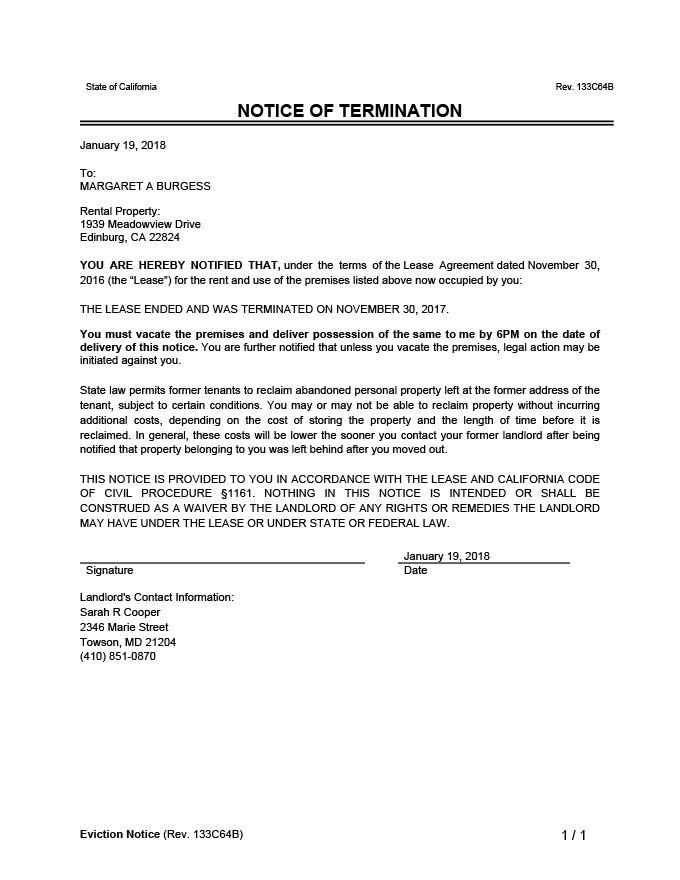
1. When an Eviction Letter is Needed
An eviction notice is used to inform the tenant that you're about to begin evicting them, but a notice is not needed if the landlord and tenant are able to resolve the problem by themselves. It is desirable in most cases to avoid serving an eviction notice to save both parties time, energy, and expense. If the tenant is late paying rent, there are some procedures a landlord can follow.
Perhaps there was a misunderstanding about the terms of the lease — did the tenant have a death in the family, suffer a work injury, or lose their job? Maybe the landlord is willing to work out a payment plan for missed rent payments. Would the tenant be willing to pay for the cost of repair to fix the damage caused to the premises?
Sometimes a sincere apology, candid communication, and an honest willingness to cooperate can save both the landlord and tenant time and money in the long term.
If the disagreement cannot be solved and the landlord wants to end the lease agreement and properly ask the tenant to leave by a certain date, they should send an eviction notice.
Even though the tenant is being asked to leave by a certain date, the tenant has the right to stay in the premises until a judge has heard from both the landlord and the tenant.
A court order is needed before a landlord can evict a tenant. If the tenant does not voluntarily vacate or move out, even after the judge issues an official court order, a sheriff or other law enforcement officer may forcibly remove the tenant and their belongings.
In the hurry of voluntarily moving out, the tenant may also leave their furniture and personal belongings. Before a landlord is tempted to sell off these abandoned personal items, it is wise to check local and state laws. Some states require landlords to store these abandoned belongings for a certain time, while others allow landlords to sell these items, but only after they have contacted the tenant, posted a notice in the newspaper, or followed other strict procedures.
2. How to Handle the Eviction Process
If a landlord doesn't strictly follow the proper procedures, the tenant can challenge the eviction on a technicality and force the landlord to re-start the whole process.
For example, if the landlord was required to give a 10-day notice but only gives a 3-day notice, the tenant may be able to claim that you violated their right to due process. A landlord should consult their local housing laws and carefully follow the strict steps needed to evict a tenant properly.
It's my house! Can't I just kick out a bad tenant?
Even if a tenant may be actively damaging the premises, a landlord may NOT resort to self-help measures. Instead, the court will require the tenant to move out sooner if the landlord is right. In most states, self-help measures are ILLEGAL.
A landlord may NOT:
- Change the locks
- Put padlocks on the door
- Remove outside doors or windows
- Shut off the lights, gas, or water
- Move out the tenant's furniture
- Intimidate or harass the tenant to move out
- Physically remove the tenant (i.e., Uncle Vinny can NOT help you)
The landlord MUST use the court-administered eviction process to remove the tenant from the premises.
Ultimately, only the courts have the power and authority to decide whether an eviction can legally take place.
What happens if I receive an eviction notice?
While the notice is NOT a court order to leave, do NOT ignore it.
An eviction notice allows the landlord to START the eviction process in court if the tenant cannot resolve the problem and comply with the lease agreement.
The landlord MUST receive a court order or judgment from the court to make you leave.
If you receive an eviction notice, try the following immediately:
1. Talk with your landlord and come to a mutual understanding
Perhaps there was a misunderstanding about the terms of the lease? Did the tenant have a death in the family, suffer a work injury, or lose their job? Maybe the landlord is willing to work out a payment plan for missed rent payments? Would the tenant be willing to pay for the cost of repair to fix the damage caused to the premises?
Having a simple conversation may be the cheapest way to resolve the problem.
If the lease is ambiguous or does not cover the situation at hand, you might also consider local mediation or arbitration resources available in your town or city. Alternative dispute resolution services can sometimes serve as a faster and cheaper alternative to the traditional court process.
2. Hire a private attorney
If you have the means and the stakes are high, it may pay off, in the long run, to hire an attorney to guide you through the detailed eviction process.
Even if you do not have the means to pay, some attorneys may also accept clients on a contingency basis, so you only pay if the attorney is successful. For example, your attorney would agree beforehand that if you win, the attorney will subtract court costs like filing fees and a fixed percentage (usually one-third) from the amount won.
Other attorneys who are very familiar with the local housing process may only charge a flat fee.
As a client, be sure to ask detailed questions about the fee structure and expected costs.
3. Contact government agencies and offices
With a little bit of research, you may also discover that your local or state government offers helpful landlord-tenant services. An increase in homelessness would further burden municipal services, so some local governments invest resources in providing housing assistance to prevent such problems. For example, try finding the following:
City Resources
- Human Rights and Human Services Department
- Consumer Protection Agency
- Housing Agency
- District Attorney's Office
- City or County Rent Control Board
State Resources
- Health and Human Services Department
- Housing Authority
4. Find a helpful nonprofit
Because housing affects everyone, there are many 501(c)(3) nonprofit organizations that specialize in offering assistance to landlord-tenant disputes. Depending on your economic situation, you may qualify for subsidized or free legal services. Here are a few possible sources of additional help:
- Legal Aid Organization
- Housing Clinic
- Local Law School Public Interest Clinic
- Tenant Organization
- Tenant-Landlord Programs
5. Represent yourself in court
Another option is to simply appear before the judge without legal counsel, also known as appearing pro se or "for yourself."
In some states like Massachusetts, the housing court may offer something akin to a Lawyer for a Day program, which provides limited legal advice on a pro bono (free) basis to tenants and landlords on a first-come, first-served basis.
Before going to court, be sure to collect any documents, photos, and information that may help explain or support your side of the story. Remember to prepare beforehand and practice giving a short and clear explanation of what happened. The judge often has a large caseload and is often under a lot of pressure to get through many cases quickly.
The more organized your story and documents are, the more grateful the judge will be for helping them understand and resolve your problem faster.
Here are some other tips:
- Prepare your explanation beforehand
- Address the judge as "Your Honor"
- Speak loudly and clearly
- Dress modestly and appear professional (i.e., wear your Sunday best)
- Be courteous to the other party (i.e., no yelling or name-calling)
What if this eviction notice is not fair?
Perhaps the tenant withheld rent and didn't pay because the landlord didn't fix the air conditioner? Maybe the landlord is unlawfully retaliating against the tenant for reporting a housing code violation (i.e., retaliatory eviction)? Perhaps the landlord started treating the tenant differently once they met their same-sex partner or started dating a person of a different race or nationality?
As a tenant, you may have good reasons for not being evicted.
Explore possible affirmative defenses if you think your landlord is unlawfully evicting you.
What happens if I am evicted?
In addition to not having a place to live, your credit may also suffer. A judgment against the tenant will be reported on your credit score for seven years.
Additionally, past evictions show up on background checks. Having been evicted, you may find it is harder to find housing in the future since a rental application usually requires a background check.
6 Ways to Avoid Eviction Costs & Headaches
If you don't enjoy unexpected and unnecessary costs, you can take the following steps to avoid these problems and save yourself a big headache.
Each of these steps requires using specific forms to notify the tenant (all of which you should save copies of):
- Use a Rental Application to find a hassle-free tenant and confirm their:
- work status
- credit check
- background check
- current financial ability to pay
- references from past landlords and property managers
- Use a Late Rent Notice to document each time rent is past due (again).
- Use a Notice of Lease Violation to require the tenant "cure" a problem.
- Use a Notice of Termination to warn that the lease will not be renewed.
- Use a Notice of Rent Increase to warn that rent is being raised.
- Use a Landlord's Notice to Enter to notify tenants (usually 24 hours in advance) to:
- Inspect the premises for maintenance like painting and heating
- Check whether the lease or rental agreement is being complied with
- Note: Not required if there is an emergency like a fire or burst pipe
3. What Should be Included in the Eviction Notice?
An eviction notice should answer: 1. Who 2. Why 3. Where 4. What 5. When
1. Who this applies to
- The tenant's name and address
- The landlord's name and address
2. Why there is a reason for an eviction
- Failure to Pay Rent
- Lease Violation
- Month to Month Tenancy Ended
- Lease Expired (i.e., Holdover Tenant)
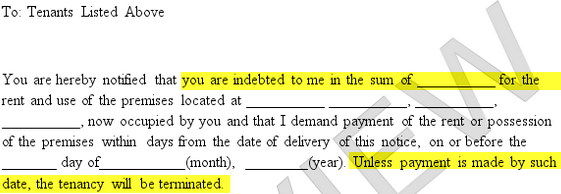
3. Where the eviction is occurring
- The "Address" or the "Premises"

4. What should be done to fix the problem
- The name and date of the original lease agreement
- A reference to the lease about how the tenant can fulfill their promise
5. When
- The notice is in effect (the "Notice Date")
- The tenant must pay rent or leave the premises by a certain date ("Deadline")

4. Free Eviction Notice Sample
The following downloadable eviction notice sample is for when your tenant has failed to pay rent, also known as a notice to pay rent or quit. If you wish to send your tenant an eviction notice for a different reason, or if you simply wish to save time, you can use our software to create your eviction notice online.
Eviction Notice
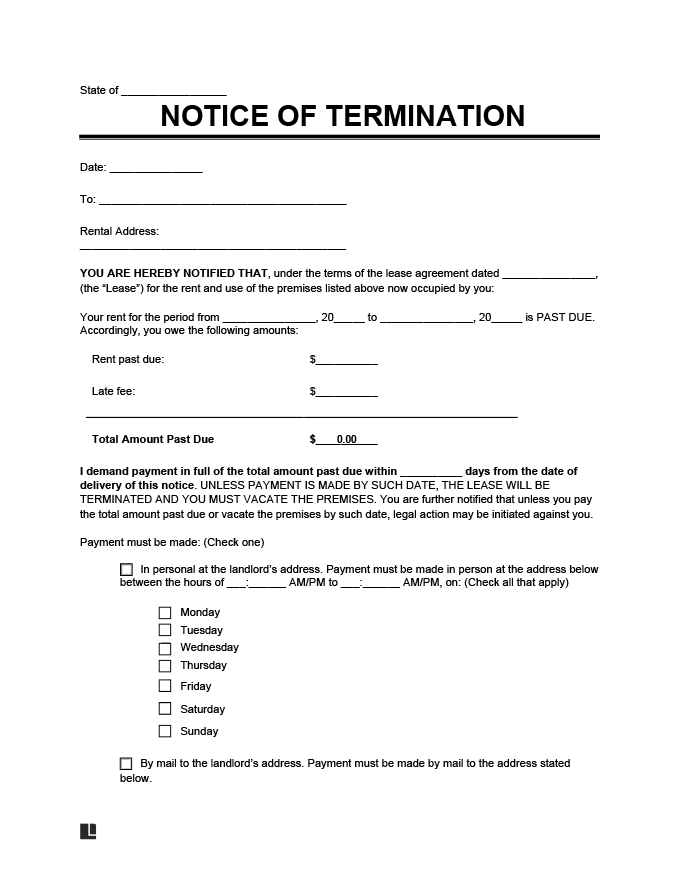
Related Documents
- Lease Termination: Inform a tenant that their month-to-month rental agreement will not be renewed.
- Late Rent Notice: Let your tenant know that they haven't paid their rent on time, and they're at risk of being evicted.
5. Eviction Notice FAQs
What is an eviction notice?
An eviction notice is a formal letter from the landlord to the tenant and officially explains that the tenant must fix or "cure" the problem, or move out by a certain date. It also notifies the tenant that both parties may need to go to court to continue the eviction process.
The types of eviction notices are:
- Pay Rent or Quit Notices ("Failure to Pay Rent")
- Cure or Quit Notices ("Lease Violation")
- Unconditional Quit Notices ("Ending a Month-to-Month Tenancy" or "Holdover Tenant")
What are possible reasons for eviction?
- The tenant has failed to pay rent. If the tenant has not paid rent, the landlord can use the eviction notice to notify the tenant to pay the rent that is due. If the rent is not paid by a certain date, the tenant must leave the premises.
- The tenant has violated the lease agreement. If the tenant has violated the lease agreement, the landlord can use the eviction notice to notify the tenant to leave the premises by a certain date. In some cases, the tenant is also given the option to remedy or correct the violation by a certain time in order to not to be evicted.
- I wish to terminate a month-to-month tenancy. If the current agreement is a month-to-month rental arrangement, the landlord can use the eviction notice to notify the tenant that their month-to-month tenancy will end by a certain date.
- The lease has ended and the tenant has remained on the property (holdover). If the tenant has stayed on the property past their lease end date, the landlord can use this eviction notice to notify the tenant that they must leave the premises.
How long does it take to evict someone?
It usually takes 1 to 3 months to evict someone. The length of the eviction process depends on state laws — some states only require landlords to send a 3-day notice to quit, but others require 30 or more days notice.
How do I write an eviction notice?
Here's how you write an eviction notice:
- Write the tenant and landlord's names and addresses
- Give the reason for eviction
- Explain what can be done to fix the problem (and avoid terminating the tenancy)
- Say when this needs to be done by
- Sign and date the form
- Serve the eviction notice to the tenants
What does the property address include?
This is the address and location of the property (or "Premises") being leased or rented out. Be sure to include any room or apartment number as part of the street address, if it applies to your type of housing. This is the address from which the tenant is being evicted.
Where do I find the name of my agreement?
Your lease or rental agreement should have the title or name of the document at the top. Common names are: Lease Agreement, Rental Agreement, or Residential Lease Agreement.
How to Write an Eviction Letter to a Tenant
Source: https://legaltemplates.net/form/eviction-notice/
0 Response to "How to Write an Eviction Letter to a Tenant"
Post a Comment